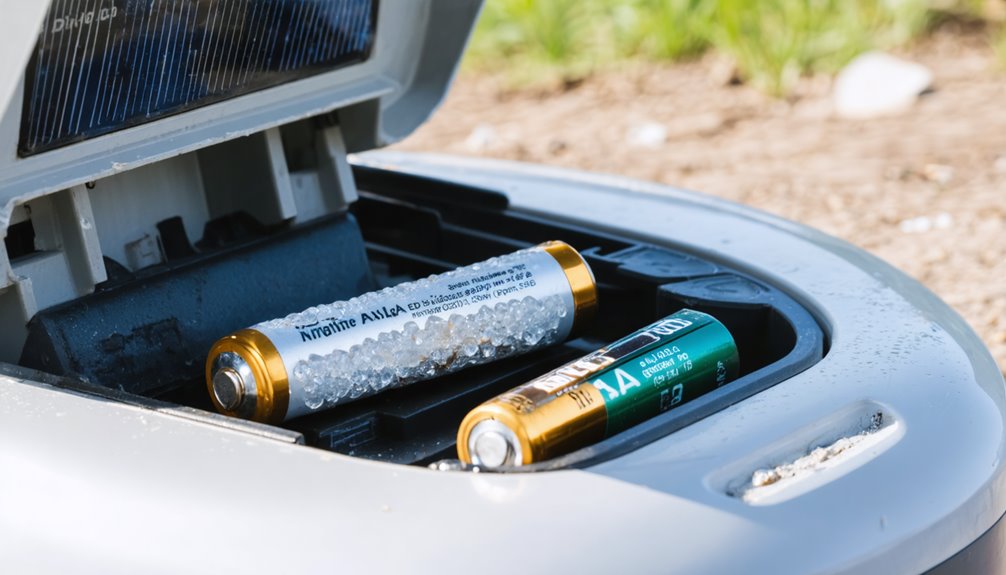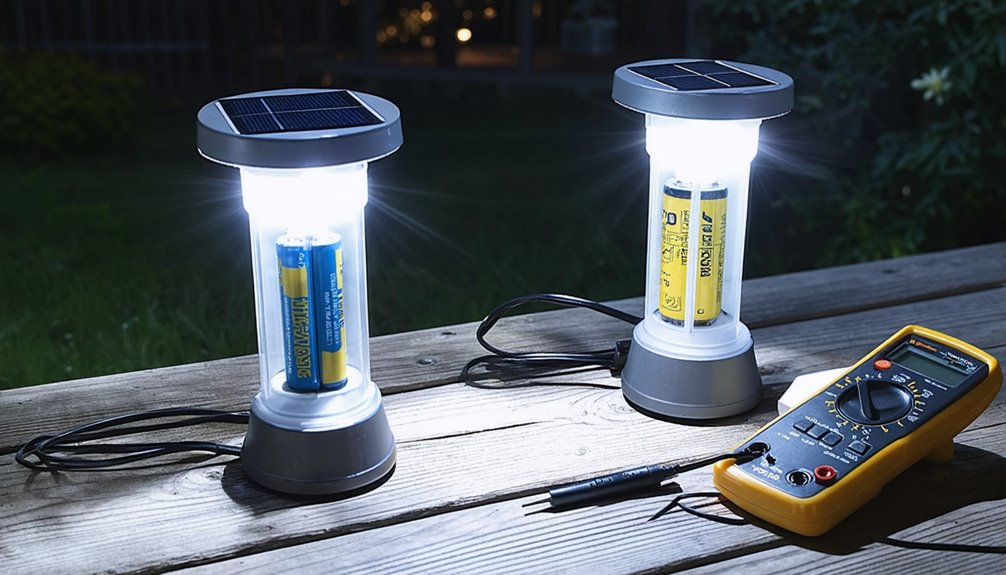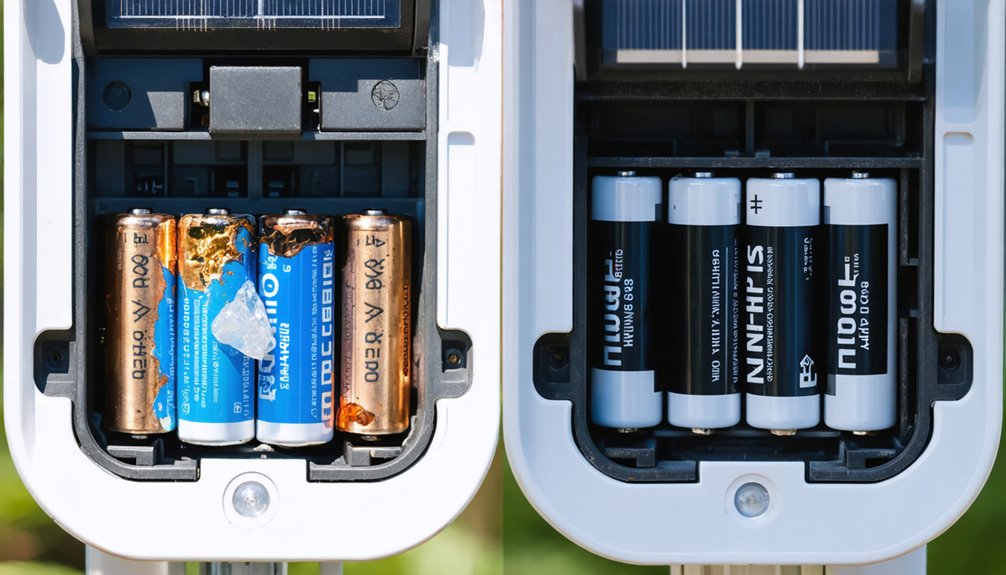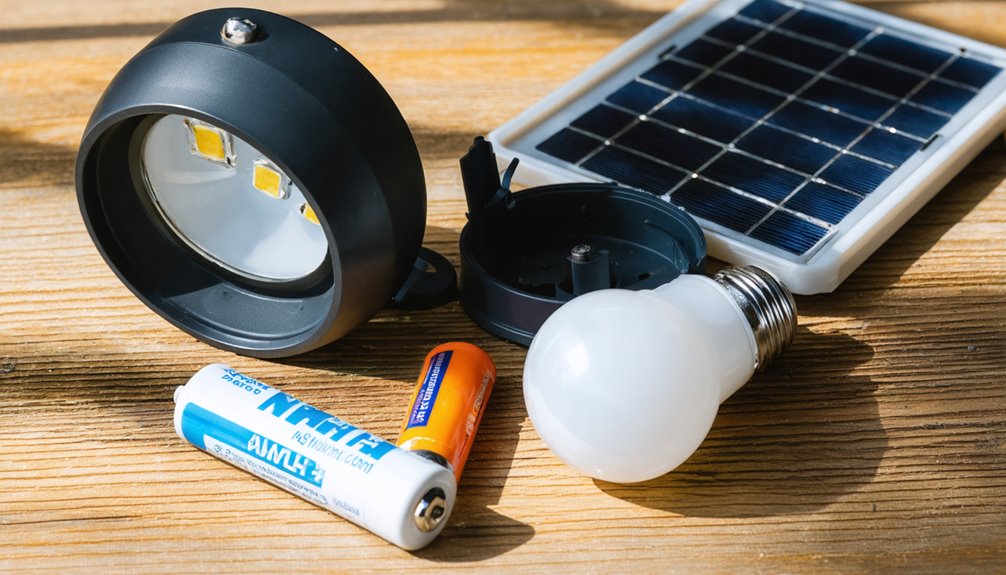You’ve just bought solar lights for your garden. You’re wondering if those regular batteries in your drawer will work instead of buying special ones. Here’s what happens: regular batteries can’t handle the daily recharge cycles from solar panels. They’ll leak, corrode, and damage your lights. But there’s more to this battery puzzle that affects how well your solar lights perform.
Why Solar Lights Need Rechargeable Batteries
When you’re considering batteries for your solar lights, you’ll need rechargeable batteries that can store energy collected during daylight hours. Solar batteries work differently from regular ones. They charge up when the sun’s out and power your lights at night.
Regular batteries can’t handle this daily charging cycle. They’re made for one-time use. Rechargeable batteries like NiCad and NiMH types can charge and discharge hundreds of times. That’s what makes them perfect for solar lights.
Your solar panels collect sunlight and convert it to electricity. This electricity needs somewhere to go. Rechargeable batteries store energy until it’s dark. Then they release power to light up your yard. Without the right batteries, your solar lights won’t work properly. They might even get damaged.
To ensure the longevity and efficiency of your solar lights, it’s crucial to selecting the correct battery type and performing regular maintenance.
How Solar Light Battery Systems Work
Before your solar light can brighten up your yard, it needs to go through a simple but clever process. During the day, solar panels on top of the light capture sunlight. These panels convert the sun’s rays into electricity. This electricity flows into rechargeable batteries inside the light fixture.
The rechargeable batteries store solar energy throughout the day. They’re usually NiCad or NiMH types. These special batteries can charge and discharge hundreds of times. That’s different from regular batteries, which can’t recharge.
When darkness falls, the stored energy powers LED bulbs in your solar light. The batteries release their saved electricity, creating illumination. This cycle repeats daily – charging by day, lighting by night. Additionally, incorporating battery storage offers advantages such as backup power during outages, ensuring reliability even on cloudy days or extended periods without sunlight.
Differences Between Regular and Rechargeable Batteries
Those special rechargeable batteries in your solar lights work differently than the regular AA or AAA batteries you’d use in a flashlight. Regular batteries provide power once and then they’re done. You can’t recharge them. Rechargeable batteries can store energy over and over again. That’s why solar lights need them.
Your solar lights absorb sunlight during the day. They need rechargeable batteries like NiCad or NiMH to store energy for nighttime use. Regular batteries can’t handle this repeated charging cycle. They’re made for single use only. Some rechargeable batteries even offer features like smart energy management capabilities to optimize their efficiency within solar systems.
Here’s another key difference: rechargeable batteries last about two years in solar lights. Regular batteries would last longer in other devices, but they don’t work properly in solar systems.
What Happens When You Use Regular Batteries in Solar Lights

If you put regular batteries in your solar lights, you’ll damage the entire lighting system. Regular batteries can’t handle the charging process that solar panels provide. They’ll overflow, leak, or corrode inside your lights. Your solar lights won’t work properly with regular batteries. They can’t store the solar energy collected during the day. The lights’ performance drops fast, and they might stop working completely. Regular batteries aren’t made for the constant charging and discharging that happens in solar lights. This mismatch causes permanent damage to the light’s internal parts. Additionally, the longevity of solar batteries can be compromised if improper batteries are used, as regular batteries lack the durability needed for the conditions solar systems experience.
| Problem | Regular Batteries | Rechargeable Batteries |
|---|---|---|
| Charging | Can’t recharge | Designed to recharge |
| Leakage | Often leak acid | Rarely leak |
| Lifespan | Damage quickly | Last 1-2 years |
Types of Rechargeable Batteries for Solar Lights
Solar lights need specific rechargeable batteries to work correctly. You’ll find two main types in these lighting systems.
NiCad batteries are the most common type of battery in solar garden lights. They’re reliable and handle temperature changes well. However, NiMH rechargeable batteries are becoming more popular. They’re better for the environment and can store more solar energy than NiCad batteries.
Your solar lights‘ performance depends on using the right batteries. The lighting system’s power needs determine which type of battery works best. Some systems need NiCad’s durability, while others benefit from NiMH’s higher capacity.
You can’t use regular alkaline batteries in solar lights. They aren’t rechargeable and will damage the system. Only rechargeable batteries can store and release solar energy properly for nighttime lighting.
Nicad Vs Nimh Battery Comparison for Solar Lighting
The choice between NiCad and NiMH batteries makes a real difference in how your solar lights perform. NiCad batteries cost less and work well in extreme temperatures. They’re tougher but aren’t great for the environment. These batteries suffer from “memory effect,” which means they’ll lose power over time.
NiMH batteries offer more eco-friendly solar lighting. They’ve got higher energy capacity and last longer than NiCad options. You’ll get better performance from NiMH batteries, but they don’t like extreme weather. They work best in moderate temperatures.
For capacity, NiMH batteries typically pack 600 to 1,000 mAh. NiCad batteries range from 300 to 1,200 mAh. This affects how bright your lights shine and how long they’ll stay on at night.
Testing Solar Light Battery Performance

You’ll need to check your solar light batteries regularly to keep them working well. Testing methods include swapping rechargeable batteries with regular ones briefly to see if the light turns on properly. If you notice your lights aren’t as bright as before, it’s probably time to test the batteries and consider replacing them.
Quick Battery Health Check
A simple test can reveal if your solar light’s rechargeable batteries need replacing. You can temporarily swap in regular batteries to check if the light works properly. This battery health check shouldn’t last long because regular batteries can damage the system.
If the light works with regular batteries but not with your rechargeable ones, that’s a clear sign of performance decline. Your rechargeable batteries likely need replacement. Poor light output or lights that won’t turn on also indicate failing batteries.
NiMH rechargeable batteries often show warning signs before complete failure. They’ll produce dimmer light or shorter operating times. Regular monitoring helps you spot these changes early. By watching your lights’ behavior, you’ll know when it’s time for new batteries.
Performance Testing Methods
Testing your solar light’s battery performance doesn’t require special equipment or technical knowledge. You’ll notice changes in how your lights work over time. Dimming or flickering shows your rechargeable batteries might be failing. Winter months can affect charging, so you’ll need to check more often during cold weather.
Here’s what homeowners typically see:
| Battery Age | Light Performance |
|---|---|
| New | Bright all night |
| 6 months | Still strong |
| 1 year | Some dimming |
| 18 months | Shorter runtime |
| 2 years | Need replacement |
Performance testing methods include watching how long lights stay on after dark. You can briefly swap in regular batteries to check if the solar light works properly. But don’t leave them in – they’ll damage your system. Most people replace their batteries every one to two years.
Signs Your Solar Light Batteries Need Replacement

You’ll know it’s time to replace your solar light batteries when you spot three main warning signs. Your lights might start dimming or flickering instead of shining brightly, or they won’t stay on as long as they used to through the night. In some cases, the lights won’t turn on at all, even after a full day of charging in the sun.
Dim or Flickering Output
When your solar lights start dimming or flickering, it’s usually because the rechargeable batteries inside them are wearing out. You’ll notice these signs when the electricity produced isn’t enough to power the lights properly. The dim or flickering output happens more often after the batteries have been used for extended periods.
| Symptom | What It Means | When It Happens |
|---|---|---|
| Dimming | Battery capacity dropping | After 1-2 years |
| Flickering | Inconsistent power flow | During cold weather |
| Complete darkness | Battery failure | End of lifespan |
Winter weather makes these problems worse. Even when your lights get plenty of sunshine during the day, old batteries can’t store enough power. If you’re seeing these symptoms regularly, the batteries have likely reached the end of their useful life.
Shorter Operating Hours
Solar lights that shut off after just a few hours point to failing batteries inside them. You’ll notice shorter operating hours when batteries can’t hold their charge anymore. This happens more during winter months when there’s less sunlight to charge them.
Your lights might run for only two or three hours instead of the usual eight to ten. That’s a clear sign you need battery replacement. Whether you’re using standard rechargeable batteries or a lithium-ion battery, they don’t last forever.
Regular monitoring helps you catch these patterns early. If you see your lights consistently turning off too soon, it’s time to check the batteries. Don’t wait for complete failure. Shorter operating hours tell you the batteries are wearing out.
Complete Light Failure
Even after a full day of charging in sunlight, some solar lights won’t turn on at all. This complete failure means your batteries come to the end of their life. When solar panels generate electricity during the day, that solar energy is stored in rechargeable batteries. Dead batteries can’t hold this charge anymore.
| Warning Sign | What It Means |
|---|---|
| No light at night | Batteries can’t store power |
| Zero response | Total battery failure |
| Dark pathways | Safety concerns arise |
| Wasted sunlight | Energy isn’t being saved |
| Failed system | Time for new batteries |
Most solar batteries last one to two years. Winter weather makes battery problems worse. If your lights stay dark after sunny days, they’re telling you it’s replacement time.
Average Lifespan of Solar Light Batteries
The batteries inside your solar lights won’t last forever. Most rechargeable lithium-ion batteries have an average lifespan of about two years. This depends on how much solar energy they receive and how often you use your lights.
Some solar lights use nickel-cadmium batteries instead. These typically last between one and two years. Weather affects battery life too. Winter’s shorter days and colder temperatures can reduce how well they work.
You’ll know it’s time for battery replacement when your lights stop working for long periods. This usually means the batteries can’t hold a charge anymore. Regular maintenance helps batteries last longer. Checking your lights and keeping the solar panels clean guarantees they get enough sunlight to charge properly.
Factors Affecting Solar Battery Performance
When you’re using solar lights, several key factors determine how well your batteries perform over time. Your solar panels need regular cleaning because dirt blocks sunlight, which means less power gets stored in the batteries. Weather conditions, temperature changes, and how many hours of direct sunlight your panels receive each day also play major roles in battery performance. To further ensure the efficiency of your solar charging system, it’s crucial to use a charge controller to prevent battery overcharging and prolong the life of your batteries.
Sunlight Exposure Duration
If your solar lights aren’t performing well, sunlight exposure might be the culprit. Solar lights need 6-8 hours of direct sunlight daily to store energy properly. When panels don’t get enough sun, they can’t convert and store solar energy effectively in their batteries.
Winter’s shorter days reduce charging time considerably. You’ll notice dimmer lights and shorter operating times during these months. The sun’s lower angle also means less intense rays reaching your panels.
Dirty panels block sunlight too. Dust, leaves, and bird droppings prevent proper absorption. Even a thin layer of grime can cut charging efficiency dramatically.
Full sunlight exposure actually extends battery life. When solar energy is stored consistently under ideal conditions, batteries last longer and perform better throughout their lifespan.
Temperature and Weather
Temperature swings hit solar batteries hard, cutting their efficiency and shortening their lifespan. Cold weather reduces charging efficiency and your lights’ operational output. When it’s hot, battery performance drops faster, especially with nickel-cadmium types that typically last two years.
You’ll notice problems during cloudy or rainy days too. Your lights can’t gather enough solar energy, which means shorter battery life and dimmer illumination at night. Winter’s particularly tough on these systems. Shorter days and weak sunlight mean your batteries won’t charge properly, so you’ll replace them more often.
Keeping solar panels clean helps optimize temperature-related performance issues. Without proper maintenance, weather conditions make battery problems worse. These environmental factors explain why your solar batteries might fail sooner than expected.
Maintenance and Cleanliness
Dust and debris block your solar panels from absorbing sunlight, which cuts your battery’s charging power dramatically. Regular maintenance keeps your solar lights working properly. When panels stay dirty, less energy is stored in the batteries.
You’ll need to clean the solar panels often. Dirt buildup happens quickly, especially in dusty areas. This affects how well your batteries charge during the day.
Clean panels mean better solar energy collection. Your batteries will charge more efficiently when the panels aren’t covered in grime. Well-maintained systems make batteries last longer too.
The type of rechargeable battery matters. NiCad and NiMH batteries have different charging needs. Each type responds differently to maintenance routines.
Performance problems often come from poor upkeep, not bad batteries. Regular checks help you spot issues early.
How to Replace Solar Light Batteries Properly
Most solar light owners need to replace their batteries every one to two years. You’ll know it’s time when your lights don’t stay bright as long as they used to.
Before replacing batteries, you should check that your solar panel’s clean. Dirt blocks sunlight and affects how panels use solar power to store energy. You’ll need rechargeable batteries made for solar lights – either NiCad or NiMH types. Regular batteries won’t work and can damage your system.
To replace them, you’ll open the battery compartment carefully. Take out the old batteries and put in new ones. Make sure the positive and negative ends match up correctly. You should dispose of old batteries at recycling centers that follow local rules.
Maintaining Solar Panels for Optimal Battery Charging
While your solar light batteries need proper care, the solar panels that charge them require regular attention too. Dirty panels can’t absorb sunlight well, which reduces how much energy they’ll store.
You’ll need to clean your panels every few months. After storms or season changes, they’ll likely need cleaning sooner. Dirt and debris block sunlight from reaching the panels.
When you’re cleaning, you’ll want to use soft cloths or sponges with mild soap and water. Hard materials can scratch the panels and make them less effective.
The panels’ angle and position affect how much sunlight they’ll catch during the day. You’ll also need to check for physical damage or things blocking the panels. These maintenance steps help your batteries charge better and last longer.
Best Practices for Extending Solar Battery Life
After you’ve invested in solar lights, you’ll want to make sure their batteries last as long as possible. You’ll need to check your lights’ brightness regularly. When they start dimming, it’s time to replace the batteries. Most solar light batteries last one to two years.
You can’t use regular batteries in these systems. They’ll damage your lights. Instead, you’ll need rechargeable NiCad or NiMH batteries. These are the only types that work properly with solar charging systems.
Consider how solar battery systems can offer long-term savings by reducing reliance on grid electricity during peak hours.
Your lights need plenty of sunlight to charge well. Place them where they’ll get direct sun exposure. During winter, they won’t charge as much. You’ll need to check the batteries more often in cold months to keep your lights working properly.
Conclusion
You can’t use regular batteries in solar lights. They’ll leak and damage your system. Regular batteries aren’t made for repeated charging cycles. They’re designed for one-time use only. Solar lights need rechargeable batteries like NiCad or NiMH types. These batteries handle multiple charging cycles without breaking down. They’ll keep your solar lights working properly for years. Using the right batteries protects your investment and guarantees your lights work when you need them.


